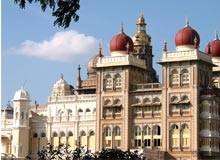| Location: | Mysore, Karnataka |
| Built In: | 1912 |
| Built By: | Henry Irwin (British Architect) designed it for the Maharaja of Mysore |
| How to Reach: | Easily reachable from anywhere in Karnataka |
 One of the largest palaces in India, Mysore Palace of Karnataka is a fine example of unique blend of different styles of architecture. The Mysore Palace is one of the most attractive and gorgeous monuments in Karnataka. It is also known by the name of Amba Vilas and was the residence of Wodeyar Maharaja. The Mysore Palace was rebuilt in 1912 after the original palace was destroyed in a fire accident in the year 1897. It was re-designed in Saracenic style by a famous British architect Henry Irwin. One can see the blend of different forms of architecture and design in the Maysore Palace.
One of the largest palaces in India, Mysore Palace of Karnataka is a fine example of unique blend of different styles of architecture. The Mysore Palace is one of the most attractive and gorgeous monuments in Karnataka. It is also known by the name of Amba Vilas and was the residence of Wodeyar Maharaja. The Mysore Palace was rebuilt in 1912 after the original palace was destroyed in a fire accident in the year 1897. It was re-designed in Saracenic style by a famous British architect Henry Irwin. One can see the blend of different forms of architecture and design in the Maysore Palace. The palace has three stories and a series of square towers with domed arches. A gold-plated dome about 145 feet from the ground covers the open courtyard in the center. The architecture has a blend of Hindu, Mughal, Rajput and Gothic styles. The entrance of the palace has 'Gombe Thotti' or Doll's Pavilion, which has a collection of Indian and European sculptures and ceremonial objects. The main gate of the palace building is known as Elephant Gate and is beautifully decorated with floral motifs and the royal symbol of Mysore, the two-headed Eagle. One finds the royal ceremonial elephant howdah decorated with 84 kilograms of gold and other precious stones.
The south of the Palace has the splendid Kalyana Mandapam" or the wedding pavilion, which is decorated with multi colored stained glass with peacock motifs arranged in geometrical patterns. One can find elaborate chandeliers and tall slender wrought iron pillars imported from countries like Scotland and Czechoslovakia. The floor is made up of glazed tiles that have been imported from England. The walls are decorated with paintings depicting the celebration of Dusshera festival during the royal rule.
The second floor has the splendid durbar hall known as 'Diwan-I-am', which is around 155 feet long and 42 feet broad. The hall is marked by an exquisitely decorated ceiling, a glistening floor and sculptured pillars that are painted in gold. The walls have murals depicting the eight avatars of Goddess Shakti. There are paintings that depict scenes from the Ramayana and Mahabharata and also an original painting of the famous painter Raja Ravi Varma. Towards the south on the same floor is the Diwan-I-Khas (private audience hall), which is decorated with beautifully carved entrance doors and stained glass ceiling.
The palace is surrounded by twelve temples, spread in the compound. Most of these are built in the Dravidian architectural style. The famous ones include Varashaswamy Temple, which has actually inspired the design for Sri Chamundeswari Temple on Chamundi Hill. The temples are decorated beautifully during special occasions like festivals and other auspicious days. The Department of Archaeology and Museums of Karnataka Government now looks after the maintenance of Mysore Palace. The palace has the largest collection of gold items (quantity wise). The famous 200-kilogram gold throne is kept for display every year during the festival of Dusshera. Every Sunday night the monument looks like a heavenly palace as it is illuminated with thousands of light bulbs.
No comments:
Post a Comment